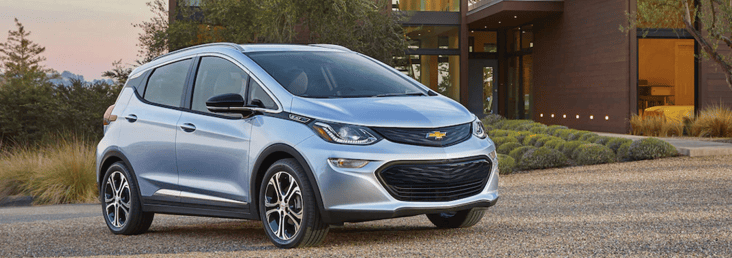This post is one in a series of feature stories on trends shaping advanced energy markets in the U.S. and around the world, drawn from Advanced Energy Now 2017 Market Report, which was prepared for AEE by Navigant Research.

The LA Times reported last month that the release of the Chevy Bolt, a plug-in electric vehicle (PEV) with a baseline price under $30,000 after federal tax credits, has boosted EV sales in California by 91% over last year. This is part of a larger trend we identified in our Advanced Energy Now 2017 Market Report, which was prepared for AEE by Navigant Research.
The PEV market is now well-established in North America, Europe, and developed Asia Pacific markets. This has largely been a function of strong government support for PEV technologies through fuel efficiency regulations, which stimulate the supply of PEVs, as well as incentives for PEV purchases, which stimulate demand. As a result of the two-pronged approach to PEV market development, the PEV market has grown from around 30,000 vehicles in 2011 to over 500,000 in 2015, and now an estimated 684,000 in 2016. This translates to a six-year compound annual growth rate (CAGR) in unit volume of 87%, and nearly $7.8 billion vehicle sales revenue in 2016.
With the market on a steady foundation, automakers are beginning to develop offerings and technologies that will likely accelerate market acceptance, including improvements in all-electric range, cost, and charging time. Most notably, General Motors (GM), Nissan, and Tesla will soon offer PEVs with ranges of 150 to 250 miles, at cost points below $40,000, which will make them competitive with traditional internal combustion engine vehicles. In line with these plans, many automakers are strategizing on the development of fast-charging networks for both inter- and intra-city travel.
As of the end of 2016, light duty PEVs accounted for about 26% of the global light duty EV market; hybrid electric vehicles, which are included as EVs, account for the remainder. PEVs, which are more expensive than hybrids, generated a larger share of the EV market’s near $90 billion 2016 estimation at over 35%. Navigant forecasts that in 2025, light duty PEVs are expected to capture between 70% and 75% of the EV market. The growth of PEV market share will be aided in part by the number and variety of PEV offerings coming to the market over the next several years. It will also be due to the continued drive to reduce carbon emissions and improve vehicle fuel economy in the major developed vehicle markets.
Following a slowdown in 2015, Navigant Research estimates that the North American market grew 38% in 2016 from 2015 levels, nearing 160,000 sales. Last year’s sales were buoyed by deployment of the next-generation Chevrolet Volt and Tesla Model X, both of which had their first full year of sales. More automotive giants introduced new PEV models near the end of the year, including the Toyota Prius Prime and the much-anticipated 200+ mile Chevrolet Bolt. Navigant Research expects the introduction of the Tesla Model 3 in late 2017, along with full year sales of the Bolt and Prius Prime, to boost the market between 47% and 60% in 2017. This is a growth pattern Navigant Research sees lasting into 2018: With a full year of Tesla Model 3 sales in 2018, growth is likely to be between 45% and 54%.
After 2018, strong but stable growth is expected, with a CAGR from 2018 to 2025 of nearly 21%. By 2025, Navigant Research anticipates that PEVs in certain small car segments with low ranges will have achieved cost parity with conventional counterparts without subsidies. Achieving this threshold, combined with a growing field of cost competitive long-range PEVs and expansion of public and workplace electric vehicle charging options, provides an indication that market growth is likely to accelerate after 2025.
The PEV market in the United States has been concentrated on the West Coast, with PEV market share in California exceeding 5% in 2016. Hawaii and Washington are likely to maintain the significant market growth both states witnessed over the last five years. Outside of the West Coast, a group of eight states in the Northeast (Maine, Vermont, Massachusetts, Connecticut, Rhode Island, New York, New Jersey, and Maryland) is likely to see sales increase considerably as automakers respond to state policies, including the adoption of the Zero Emission Vehicle mandate, by encouraging electric vehicle adoption with focused sales and marketing efforts. The deployment of PEVs with 200 miles of range or more and expansion of PEVs outside of small passenger car body type segments are also likely to bring Colorado and Utah, which have favorable demographics and government incentives, to the fore of PEV adoption.
Though Toyota deployed a PEV SUV in California in 2012 and 2013, PEV models have until recently been limited to passenger car body styles. At the end of 2015, new PEV introductions broke out of the passenger car segment with SUVs and crossovers from Tesla, Porsche, BMW, and Volvo. Despite success in European and Asian markets, Mitsubishi delayed the launch of the Outlander PHEV in North America, but the second-generation version of the vehicle may be made available to the U.S. market in 2017, making it the first non-premium SUV PEV. Fiat Chrysler’s introduction of the first mass-market plug-in hybrid minivan anticipated for February 2017 is another breakthrough in model type; 2017 is likely to see increased variety of electric vehicles, but market attention will be focused on sales performance of the Chevy Bolt and Tesla’s initial fulfillment of over 370,000 pre-orders, with deposit, for the Model 3.
Learn more about the advanced automotive market, as well as the rest of the advanced energy, in the free report available for download below.
